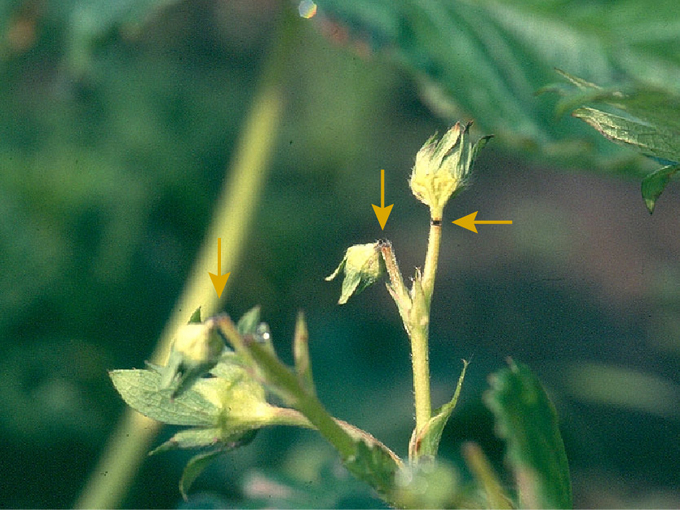Strawberry blossom weevil
Anthonomus rubi
Appearance

The strawberry blossom weevil is a small, approx. 3-4 mm large, black-grey coloured beetle that belongs to the weevil family (Curculionidae).
The legless larvae are yellowish-white in colour with a brown head and grow up to 4 mm in size.
Biology
The strawberry blossom weevils appear in spring from soil temperatures of 10-14 °C. The beetles feed on strawberry petals and various ruderal plants.
The females bore a hole in the flower bud with their proboscis, in which they lay one or more eggs, depending on the size of the flower. The beetles then gnaw at the bud stalk, the upper part of which bends over and dries out so that the bud falls to the ground. After six to eight days, the beetle larvae hatch, develop further in the bud and pupate after ten to 14 days. The pupal stage lasts about a week. In June/July, the young beetle emerges, which causes insignificant feeding damage to the leaves and moves into its winter hiding place in the soil or under plant debris in August. The strawberry blossom weevil only forms one generation per year.
Damage symptoms
Individual flower stems are gnawed and broken or bitten through. The flower buds above the damaged area dry out and fall to the ground (determined by visual inspection).
If entire inflorescence stems are damaged, it is another weevil species, the strawberry stem borer(Coenorhinus germanicus).
The damage pattern could also be caused by the Union quarantine pests Anthonomus bisignifer (Japanese strawberry blossom weevil) and Anthonomus signatus, which do not yet occur in Europe.


Prevention and control
- Treatment of the plants with plant protection products approved for this purpose (see list of plant protection products approved in Austria).
- immediately after reaching the damage threshold. The damage threshold for treatment measures is the first appearance of bent flower stems or 1 adult beetle/100m².
- In the hobby garden, flower buds lying on the ground or destroyed can be collected and destroyed as a direct measure
Specialized information
Lethmayer, C., Hausdorf, H., Blümel, S., 2004. The first field experiences with sex aggregation pheromones of the strawberry blossom weevil, Anthonomus rubi, in Austria. IOBC/WPRS Bulletin, 27(4), 133-141.
Blümel, S., 1989. the strawberry blossom weevil - interesting facts about biology and control. Better Fruit, 34(5), 127-129.
Last updated: 19.12.2025
automatically translated